[!IMPORTANT]
This post reflects my personal analysis.
It is not financial advice.
Always do your own research before investing.
[!INFO]
Information is based on data available as of 17 November 2025 and may no longer be up to date when you read this.

If you opened your stock app this afternoon, you probably got punched in the face by a big red –90%. That’s the kind of drop that usually means “fraud,” “insolvency,” or “some executive ran off with the company card.”
Except none of that happened.
The whole “collapse” was just a 10-for-1 stock split, the same one Netflix spelled out weeks ago in their official investor release. One expensive share became ten reasonably priced shares. That’s it. No drama, no scandal, just basic arithmetic doing its job.
But here’s the fun part: the interfaces most people trust to “explain the market” don’t understand any of this. Open Google Finance and it naïvely compares yesterday’s pre-split price to today’s post-split price. The chart thinks the world ended, so it paints the whole thing blood-red. Humans panic because software panics. Same story as always.
Even outlets like Fast Company jumped in immediately to calm everyone down, because apparently we now need news articles to explain basic division.

This is the problem with stock splits: the underlying business stays the same, but the UI acts like the company drove off a cliff.
As Investopedia points out, a split doesn’t change revenue, profit, subscribers, or strategy. It doesn’t even change market cap. All it changes is the granularity. Instead of owning one big slice, you own ten smaller slices. The pizza is the same size.
And if you want a sanity check on sentiment: MarketWatch notes that companies usually split stock when confidence is high — not when they’re about to implode.
Now the part that actually matters: Netflix’s fundamentals. Under the hood, the company posted record revenue, but earnings were weighed down by a one-time tax issue in Brazil — well-documented in Business Insider. Wall Street hates surprises, but analysts still mostly agree the core business is intact.
Morningstar’s analysis — What Does Netflix’s Stock Split Mean for Investors? — basically spells it out:
The fundamentals didn’t change. Only the display did.
And that’s the whole story.
The headline “Netflix down 90%” will probably float around for a few days as people screenshot charts and scream into group chats, but it’s one of those fake crises born from bad UX, not bad business. Investors didn’t suddenly lose their money. Netflix didn’t suddenly stop existing. Your app just did a subtraction it shouldn’t have.
The real narrative worth watching isn’t this visual glitch — it’s whether Netflix can keep pushing on ads, content, and international growth. That’s where the actual risk and opportunity are. Not whatever the candlestick widget hallucinated today.
Cheers!
